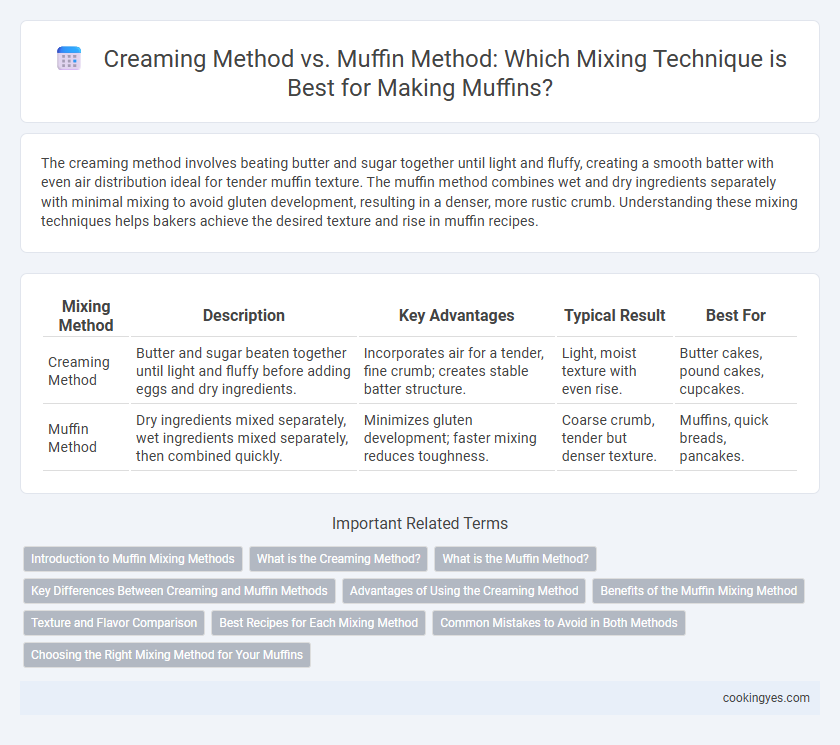The creaming method involves beating butter and sugar together until light and fluffy, creating a smooth batter with even air distribution ideal for tender muffin texture. The muffin method combines wet and dry ingredients separately with minimal mixing to avoid gluten development, resulting in a denser, more rustic crumb. Understanding these mixing techniques helps bakers achieve the desired texture and rise in muffin recipes.
Table of Comparison
| Mixing Method | Description | Key Advantages | Typical Result | Best For |
|---|---|---|---|---|
| Creaming Method | Butter and sugar beaten together until light and fluffy before adding eggs and dry ingredients. | Incorporates air for a tender, fine crumb; creates stable batter structure. | Light, moist texture with even rise. | Butter cakes, pound cakes, cupcakes. |
| Muffin Method | Dry ingredients mixed separately, wet ingredients mixed separately, then combined quickly. | Minimizes gluten development; faster mixing reduces toughness. | Coarse crumb, tender but denser texture. | Muffins, quick breads, pancakes. |
Introduction to Muffin Mixing Methods
The creaming method involves beating fat and sugar together until light and fluffy, creating a fine crumb texture ideal for butter-rich muffins. In contrast, the muffin method mixes wet and dry ingredients separately before combining them gently to avoid overmixing, resulting in a tender and slightly coarse crumb. Understanding these distinct techniques helps bakers achieve desired muffin textures and optimal rise.
What is the Creaming Method?
The Creaming Method involves beating butter and sugar together until light and fluffy, incorporating air that helps create a tender and fine-grained texture in muffins. This technique promotes even distribution of fat and sugar, enhancing moisture retention and rise during baking. It contrasts with the muffin method, where wet and dry ingredients are mixed separately to avoid over-mixing and ensure a coarser crumb.
What is the Muffin Method?
The muffin method involves mixing dry ingredients in one bowl and wet ingredients in another before combining them just until moistened, resulting in a tender, slightly lumpy batter. This method helps prevent overmixing, which can cause toughness by developing gluten excessively. Commonly used for quick breads, muffins mixed with this method yield a soft crumb and a slightly uneven texture.
Key Differences Between Creaming and Muffin Methods
The creaming method involves beating butter and sugar together until light and fluffy, creating a smooth, airy texture essential for cakes and cookies, while the muffin method combines wet and dry ingredients separately before gently mixing to avoid gluten development and produce tender muffins. Creaming allows for greater air incorporation and a finer crumb structure, whereas the muffin method emphasizes minimal mixing to prevent toughness and maintain a coarse, tender crumb. Key differences include the order of ingredient blending, mixing intensity, and the desired texture outcome for the final baked product.
Advantages of Using the Creaming Method
The creaming method enhances muffin texture by thoroughly incorporating air into the batter, resulting in a lighter, fluffier final product. This technique promotes even distribution of fat and sugar, improving crumb uniformity and moisture retention. Its ability to produce consistent rise and tender crumb makes it ideal for muffins with a delicate structure.
Benefits of the Muffin Mixing Method
The muffin mixing method benefits from minimizing gluten development by combining wet and dry ingredients separately, resulting in a tender, moist crumb perfect for softer baked goods. This technique reduces overmixing, preventing toughness and dense textures often produced by the creaming method. Ideal for quick breads and muffins, the muffin method ensures even baking and a desirable crumb structure with less effort.
Texture and Flavor Comparison
The creaming method produces a lighter, fluffier texture with a finer crumb by thoroughly incorporating air into butter and sugar, enhancing the cake-like softness and rich buttery flavor. In contrast, the muffin method yields a denser, more tender crumb because it involves minimal mixing, preventing gluten overdevelopment and preserving a moist, slightly crumbly texture. Flavor profiles differ as the creaming method emphasizes buttery sweetness, while the muffin method highlights the natural taste of ingredients with less pronounced richness.
Best Recipes for Each Mixing Method
The creaming method, ideal for butter-based recipes like classic pound cakes and layered butter cakes, produces a light, airy texture by incorporating air through beating butter and sugar. The muffin method, optimal for quick breads, muffins, and pancakes, mixes wet and dry ingredients separately before combining to avoid overmixing and ensures a tender, moist crumb. Choosing the right method depends on the desired texture and structure, with creaming favored for rich, fluffy cakes and the muffin method preferred for tender, moist baked goods with a coarse crumb.
Common Mistakes to Avoid in Both Methods
Overmixing batter in both the creaming and muffin methods can lead to dense, tough muffins due to excessive gluten development. Using improperly measured ingredients, such as too much flour or insufficient leavening agents, disrupts the delicate balance required for optimal texture and rise. Failing to incorporate ingredients at the correct temperature can also cause batter separation or uneven mixing, resulting in inconsistent crumb and poor muffin quality.
Choosing the Right Mixing Method for Your Muffins
Choosing the right mixing method for your muffins significantly impacts their texture and crumb structure. The creaming method, involving beating butter and sugar until light and fluffy, creates a tender, fine crumb ideal for pound cake-style muffins, while the muffin method, which combines wet and dry ingredients separately before mixing just until moistened, produces a coarser, denser texture with a tender crumb. Understanding these techniques ensures optimal muffin consistency, preventing overmixing and resulting in desirable rise and moisture retention.
Creaming method vs muffin method for mixing Infographic

 cookingyes.com
cookingyes.com